1966 United States Grand Prix race report: Clark prevails at last
Jim Clark wins his first race of the season, also being a first victory for the 3-litre BRM H16 engine
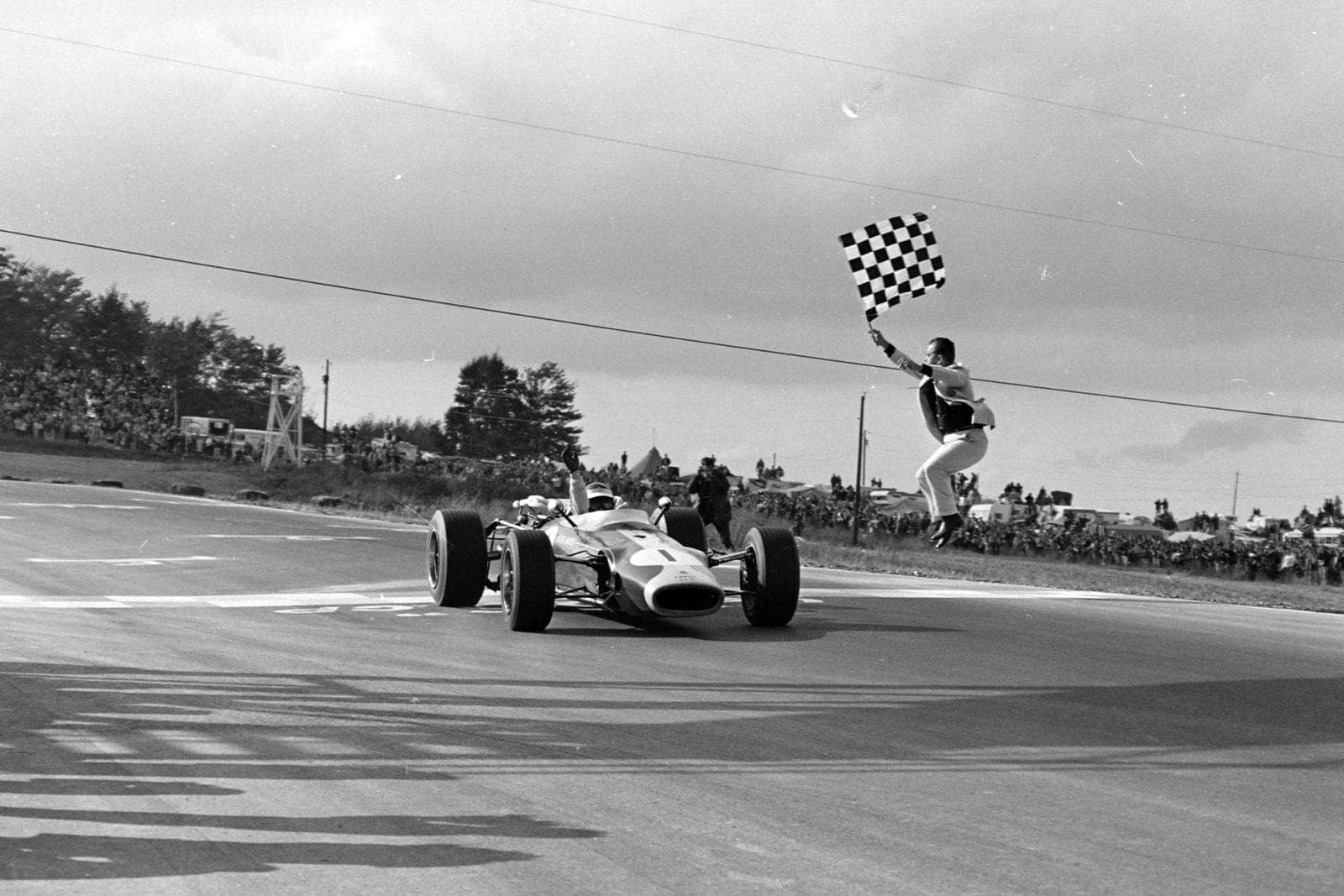
Clark takes his win of the season, powered by the BRM H16 engine
Motorsport Images
The 8th United States Grand Prix and the sixth to be held on the 2.3 mile Upper New York State circuit at Watkins Glen attracted the best technical entry of the year. This year the organisers had broken with the tradition of paying starting money. Instead they had allocated prize money from first to last places, first across the line to receive $20,000 and 20th place to receive $2,800, a total of $102,400 making this the largest purse in Grand Prix racing.
Every serious 3-litre engine was present. Team Lotus had three cars, an H16 BRM, a 2-litre V8 BRM and the 2-litre V8 Climax. The V8 BRM car was for Rodriguez and the other two for Clark and Arundell. The BRM team had been busy rebuilding the H16s shattered at Oulton Park and Monza and had three H16 cars and a spare engine. The extensiveness of the damage in the past has been due to the shattering of the cast iron liners, which has caused the bottom end castings to become mangled. To stop this, more expensive steel liners are being produced which will isolate dropped valves etc, and reduce major damage. The cars were 3-litre chassis Nos 1, 2 and 3. No 1 was the spare car, No 2 was set up for Hill and had the latest engine which is a true 16, No 3 was Stewart’s car and had a “double 8” engine.
This year’s most successful team had the two cars used at Monza and Oulton Park for Jack Brabham and Denny Hulme. On Brabham’s car Bosch ignition was being set up to try to overcome some of the problems they have had this year. Cooper’s had the same two cars they used at Monza, Surtees using the older head layout with wide angle inlet ports while Rindt used an engine with the narrow angled inlets.
The Ferrari team had only one car for Bandini, their other two entries being withdrawn. The car had the latest 3-valve heads and was a SEFAC entry as opposed to a North American Racing entry as in previous years. All American Racers had two entries for Dan Gurney and Phil Hill; the latter, however, was in hospital on the day before practice with a hernia, and Bob Bondurant took over his drive in the 2.7 Climax car which Gurney had used earlier in the season. Dan’s own car was the very compact V12 Gurney-Weslake which appeared at Monza. In the past month the faulty fuel feed has been rectified, but no track testing had been carried out so the practice sessions were to be the only time to sort out further problems.
The Honda team arrived with two cars for Ginther and Bucknum, the former having recovered from his accident at Monza. In fact, from the vigorous handshakes he was handing out he was obviously proving that his right collar-bone was completely healed. Bucknum’s car, which is chassis No 3, was the same as the Monza car except for Airheart brakes which were being tried. However, Ginther’s car, which was No 2 chassis, had a much wider track, the front being 64in, and the rear 62¾in, an increase of 7¾in back and front. Seldom has there been such a large increase without a complete re-design.
Next was the McLaren appearing again after missing the last two Grands Prix. The Ford engine had had the bottom end strengthened and the Ford Indianapolis project engineers had been breathing on the engine which now develops 325bhp. The engine still has the huge air intakes and exhausts that it had earlier in the season.
Completing the field were the four private entries, Siffert driving Rob Walker’s Cooper-Maserati, Bonnier driving his own Cooper-Maserati, Mike Spence in Parnell’s 2-litre Lotus/BRM, and Innes Ireland in Bernard White’s 2-litre BRM, the last entry, for Solana had no car due to the lack of Ferraris.
With the increased power and the fact that lap times all over Europe had fallen considerably it was obvious that the times would improve to make this a 120mph circuit. Last year’s fastest practice lap was 1min 11.16sec, set up by Clark, and this was the initial target.
Qualifying

Ferrari entered only one car for this race Bandini behind the week
Motorsport Images
Practice was over eight hours in all, four hours on Friday and four hours on Saturday. Friday was cold, dry and very windy, except for the last hour, when the wind dropped. Bonnier, McLaren and Rindt were out the moment the track was opened and soon most drivers were under way. The Gurney team was still in the tech building preparing the Climax car and after only one lap with the Weslake V12 they had low oil pressure, which kept them off the track for a time.
Brabham had the Bosch electrics fitted but it looked like a long job to get the timing right so the Lucas was switched back to allow Jack to get in some practice on the first day. The other car which was late out was Bernard White’s BRM and this was still being prepared as it was a very late entry and final preparation had to be completed on practice day.
In the first hour it was Clark who went fastest, taking 0.03sec off his last year’s time in the H16 car, which had Arundell’s number on it, but the wind on the straight was keeping times in general down. BRM were both wrongly geared and Hill’s car was wheeled off to be changed. Ginther and Bucknum were both out but before the latter could start getting any worthwhile times, second gear seized and the car was wheeled away. Ginther, however, was starting to go well but complained of hump steering and began tightening down the suspension. Before half-way through practice Ginther was under 1min 10sec with Bandini, Surtees and Stewart just behind but the wind had not yet dropped and this was still worrying the faster cars.
As the McLaren began to get into its stride, Bruce missed a gear change and the tell-tale stood at 10,600rpm when he came in, which is at least 1,000 revs, over the recommended limit. The green and white car was wheeled away to find out what, if anything, was bent, and luckily no damage was found although the Ford engineers “looking on” were somewhat surprised. With the wind dropping most drivers sat back and waited for the last half hour to really try, but Bandini and Surtees both got under 1min 10sec with Surtees being the fastest for this period.
In the last minute rush of activity two drivers broke the 120mph barrier, Bandini with a time of 1min 08.67sec and Surtees with 1min 08.73sec. The only other car to get under 1min 9sec was G Hill, who put in some consistently fast laps after his gear ratios were changed. Brabham had several runs in the last hour, getting under 1min 10sec, and was his usual inscrutable self.
Hulme’s times were not too good as he was having, firstly, timing problems, then fuel mixture problems, and these were not properly sorted out when practice ended. Clark did exactly 1min 10sec in the Climax car and did not go out again in Arundell’s H16, which had low oil pressure, when a return valve stuck.
The two private Cooper-Maseratis were in trouble. Siffert was complaining that he had a vibration, and the crown-wheel, clutch and drive shafts were examined, but nothing radically wrong could be found. Bonnier, however, felt something go in the engine, and when the head was removed the top of one of the pistons had broken off. Fortunately, the Walker team had a spare, which was fitted overnight.
The second practice period was preceded by heavy rain which turned the dirt roads and the pathways into mud baths. The track was beginning to dry when the first cars went out and all except the Brabhams and Bonnier put in some slow laps in the first hour. Bonnier had decided he had practised enough and except for running-up the engine to make sure the piston worked, the red Cooper-Maserati stayed in the tech building. The Brabhams were both ready to run, Jack’s car now fitted with the Bosch but, with a slow track and all that mud about, they decided to wait until conditions were better.
Clark did one lap in the Climax car and came in with gear trouble, then went out in the H16. McLaren did a number of laps and complained of the terrible understeer he was getting. Also the McLaren was proving difficult to start on the starter and Bruce made several experimental single laps, then stopped the engine and tried to re-start; working progressively, he found 15 flips gave a better chance of restarting than cutting immediately.
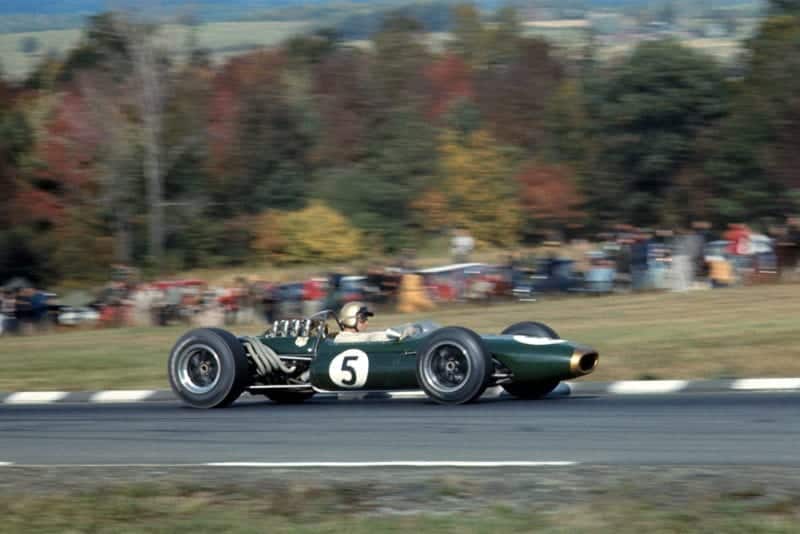
Brabham set fastest time to secure pole
Motorsport Images
Both Gurneys were out early and the V12 was beginning to sound good—overnight one of the fuel cells was changed when a bad leak was discovered, Goodyear flying in one of their air-frame experts to make the change and carry out some modification. Both BRMs now had the right ratios and the third car was brought out for both drivers to try. After some laps, Stewart asked to have the No 1, 3-litre car and the mechanics set about adjusting it as his race car, but for the rest of practice it still had the wrong gear ratios.
Both Hondas did a lot of laps, Bucknum’s now being back on to the original brakes, but the times were not improving as the modifications to get over the bump steering and other faults were not working. Bucknum had the suspension so stiffened that it was hardly working at all but like this it felt better in a straight line. As the track dried out completely, the times improved, then in the last hour the usual activity started.
Clark, who had not been able to get very good times in the Climax car, came in, jammed in gear, and the car was wheeled off. Arundell, who was putting in a lot of laps in the H16, which resulted in two spins in front of the pits, much to the amusement of all the other teams, was called in so that Clark could have a final “go” before the track was closed. Hill’s BRM made no improvement over the previous day while, although Stewart was a bit faster, he seemed happier in the spare car, which had a slower time.
Surtees almost equalled his previous day’s time, while Rindt just bettered his. However, Rindt’s engine was using oil at a great rate, and it was suspected a piston may have been breaking up, so an engine change was made before race day. Rodriguez, in the 2-litre Lotus-BRM, was having a quiet time and with no mechanical problems, got down to 1min 10.4sec.
Gurney was beginning to get things sorted out and, although his lap times were not too good, he was timed on the straight at faster than any other car, so was obviously losing a lot somewhere else. Bondurant had no mechanical problems and quietly pressed on keeping out of the way of faster cars. Spence and Siffert both improved on their first day’s times with just over 1min 10sec.
With the last few minutes left to go, all eyes were on Brabham, for he went out with a very purposeful look on his face. Also out lapping was Clark in the H16 and it was not inconceivable that he might put in a quick one. Jack did not disappoint, for he clocked 1min 8.42sec to give him pole position. When he came in and was told his time, he allowed his face to slip for a split second into a smile of satisfaction but then it went straight back to the usual “dead-pan.”
Just as the flag was to go out to end practice, Clark squeezed the H16 that little bit more and got down to 1min 08.53sec to put him next to Brabham on the grid. As the Lotus-BRM slowed down, Clark felt something go in the engine, and when he stopped, oil was trickling from one of the exhausts. BRM, however, offered Chapman their spare so that Clark could make use of his fast time and make him really competitive.
Race
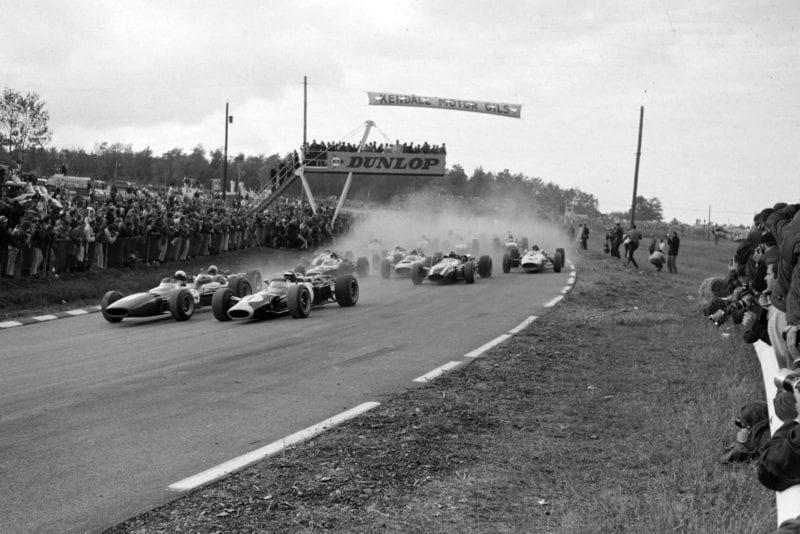
Bandini snatches the lead from Clark at the start
Motorsport Images
As practice finished a drizzle began to fall but the locals said this was the end of the bad weather. Certainly they seemed to know, for race day dawned with a cloudless sky and almost no wind, and although cloud formed later and a few spots of rain fell, it was, on the whole, good racing weather. The overnight work was completed in all teams, except Lotus, who were working on the H16 right up until the last moment. An hour before the start it still wasn’t certain if Clark would handle the 3-litre or the 2-litre car. Stewart had voted to have the spare car and his gearbox was transferred. Hill’s poor times were discovered to have been caused by the timing slipping as the revs rose and this was rectified.
As the cars were put on to the grid Clark’s position remained empty until just before the engines were started for the warming-up lap. Even when he stopped on the line, oil was running from somewhere and it wasn’t until a last nut was tightened that the oil stopped and the cars could go on their warming lap. In the more than usual confusion at the start with sheriffs in patrol cars shepherding the hangers-on behind the fences, the start was delayed a few minutes. However, when the flag did fall, Bandini made a superb start from the second row and as they went up the hill it was the red Ferrari leading from Brahham and Clark.
“Ginther, whose start was excellent, was rapidly losing ground”
When the field appeared at the end of lap 1, Bandini led by some yards from Clark, Ginther, Brabham and Surtees. A short gap, then in a string came Stewart, Hill, Hulme, Rindt, Siffert, Spence, Rodriguez, Bondurant, Gurney, Ireland, Bonnier and Bucknum, then, already dropping back, Arundell who had no time in the Climax Lotus, therefore starting at the back and, last, after a very bad start, came McLaren.
On the next lap the Ferrari was still leading and had pulled out a little more lead from Clark. Brabham and Surtees had both got past Ginther and were closing in on Clark. Ginther, whose start was excellent, was rapidly losing ground, two places on lap 2, three places on lap 3, one place on lap 5, and two more places on lap 6. While the Honda was coming down from the top, McLaren was making similar progress up from the end of the field.
On lap 2, Bonnier came into the pits as he did with regularity for the whole race. In fitting the new piston it seems that the liner had loosened and as soon as the revs reached 6,000, the water system was being pressurised and the fluid was being pumped out. Bonnier kept going slowly with regular topping-up stops.
In the lead the Ferrari still held Brabham at bay but only just, while Surtees was worrying at Clark’s heels and on lap 9 he got past, as did Brabham on lap 10, so putting the Australian ahead of Bandini. These four were now some way ahead of Stewart, who was followed by his team-mate Hill some 50 yards behind. Hulme held seventh place with Rindt just behind. Then came Spence and Siffert close together until they were split on lap 8 by Gurney, who was beginning to move up, and by lap 12 he was in 8th place.
McLaren’s progress amongst the tail-enders took him past Bondurant and then Rodriguez. As he dived inside Rodriguez at a corner, the Mexican was already turning in and the Lotus nose caught the rear wheel of the McLaren, cracking it badly. At the next turn the nose fell off right in Bondurant’s path, and the Eagle took to the long grass, where he was unable to re-start without aid, so when eventually he returned to the pits the car was retired, as if would have been disqualified. Rodriguez, minus nose, made a pit-stop and then continued into the race, last but one.
Hulme, lying in seventh place, noticed his oil temperature rising on the 10th lap as Rindt went by him, and next time round he came into the pits for a quick pit-stop, then went out again but almost last. On his twelfth lap, Rodriguez made another pit-stop as without the nose, his car was running so cold that it was beginning to misfire. When some tape blanked off some of the radiator, he did two more laps, then came in again for more blanking. This time, however, the starter failed to work and the Lotus-BRM V8 was retired. Next retirement was one lap later when Gurney, lying 8th, came into the pits with clutch slip due to oil getting on the plates. Other than this, the car had not been running too well, with both fuel and ignition faults present from the start.
The leaders were beginning to lap the tail of the field and first Brabham, then Bandini, passed Arundell, but as Surtees tried to pass him after the pits, he got shut off rather badly; then, at the next corner, in a confusion over which side to get past and the fact that Arundell slid on some oil, both cars touched wheel to wheel and spun on to the stony verge of the track. Both cars limped to the pits for a thorough check, and while there Surtees told Arundell what he thought of tailenders who haven’t learned to use their mirrors and when the car was given a clean bill of health he rejoined the leading trio, but three laps behind, and in 13th place.
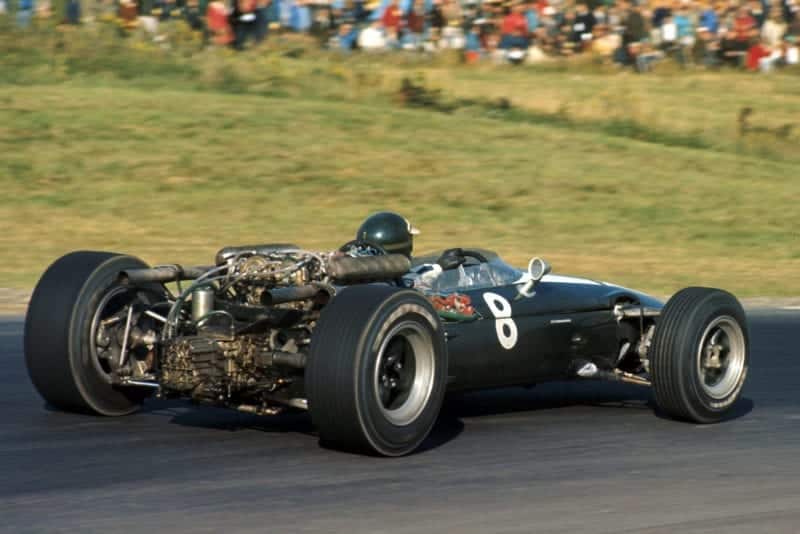
Jochen Rindt managed to finish in 2nd place, but one lap down.
Motorsport Images
While this melee was going on, Ginther came into the pits and the reason for his slowing was obvious—he was having to have two or three “go’s” at finding the gear he wanted and this was slowing him badly. On lap 19, Hulme came into the pits again, this time with not only high oil temperature but low oil pressure, so he was retired. A slight alteration had taken place at the front. Bandini had re-passed Brabham and the two of them were beginning to lose Clark, while Stewart was still falling back and Hill, until lap 21, was just keeping his team-mate in sight.
On lap 21, Hill came into the pits with a tooth or teeth missing from the gears. He went out again in eighth place until Bucknum caught and passed him. The Honda was going well, although a weird noise had started in the exhaust note. Bandini’s lead came to an abrupt end when on his 35th lap his engine suffered a major blow-up, caused probably when a part of a plug fell into the engine. Dejectedly, he coasted to the pits, leaving Brabham with a good lead over Clark’s Lotus-BRM H16 and Stewart’s H16 BRM. Behind them was Spence in the Parnell car with Siffert right on his tail, and McLaren, slowly catching them both.
“Surtees was driving now with grim determination and had passed, and was pulling away from the leaders as he started to pull his way back towards the front”
Surtees was driving now with grim determination and had passed, and was pulling away from the leaders as he started to pull his way back towards the front. As he proceeded, so each new lap record fell to him and not to one of the leading cars. Spence’s fifth place came to an end on lap 40 when his engine began to misfire badly and after two laps without it clearing, he came in with low fuel pressure. The battery was changed but this did not solve the situation and he continued, sounding very sick for many laps and finally expired when in 5th place on the 75th lap, with no sparks.
Bucknum’s noisy engine began to lose power and he came in where, to the astonishment of the Japanese mechanics, it was found that three of the exhaust pipes had burnt away, leaving only short stubs from three cylinders. After only a brief consultation, he was sent out now in 11th place where, even though the power was affected, he was soon lapping quite fast. As the 53rd and 54th laps came up, which was the halfway stage, both BRM’s retired, Hill first with a broken crown wheel and pinion, and on the next lap, Stewart pulled on to the grass opposite the pits with oil and water corning out of one of the exhausts. The on-the-spot diagnosis was that a liner had shattered but nothing seemed to have cued it.
With the BRMs out there were now only twelve cars running and one of these was more like a crawl than a run. Bonnier was still going very slowly and stopping periodically for water. Brabham was leading with Clark still within striking distance, then came Rindt, not quite a lap behind, next and a lap down came Siffert with McLaren trying all he knew to get by, but his car was lacking the necessary power. Then came Surtees, still driving as if he could catch the leaders and not wasting a single second, Ireland, Bucknum and Arundell well separated, and on different laps were 7th, 8th and 9th, while in the last two effective places were Spence and Ginther.
No sooner had the half-way stage been passed than Brabham came into the pits and, after an examination, he retired with a camshaft that wouldn’t rotate. This subsequently was discovered to have been caused by a broken cam-follower which jammed the camshaft, also as bits had been breaking off the chain was stretched to a point where it was possible to jump a tooth. Clark was now firmly in the lead. His H16 BRM engine sounded perfect, which goes to show BRM look after their customers better than themselves. Next was Rindt, just under a minute behind. Bucknum’s race ended when the engine became too rough to be tractable and he retired on lap 59.
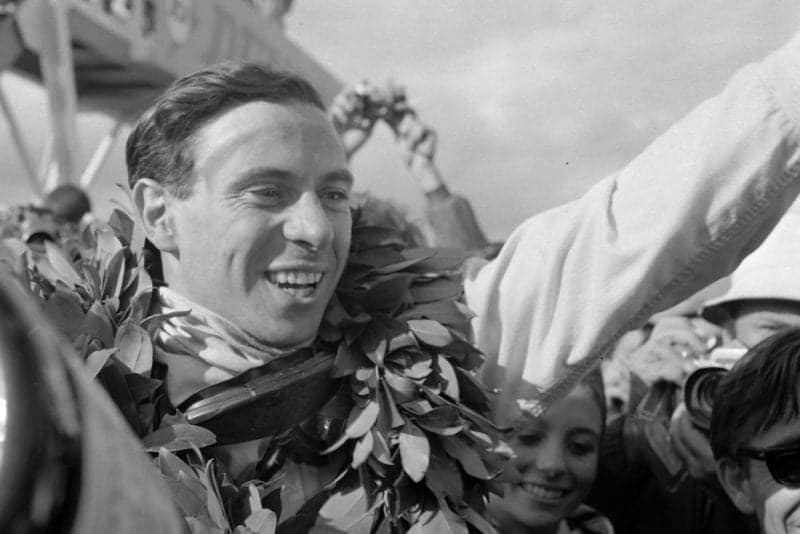
Jim Clark finally took victory in ’66
Motorsport Images
Things were now fairly well set. Surtees went past Clark and his team-mate Rindt, making him now only one lap behind them. He went past McLaren and Siffert on two consecutive laps and was now in third place. So the final laps ticked off and the only drama left was when Rindt failed to take the flag when he should, for he ran out of fuel on the far side of the circuit and took 2min 28.5sec to complete the lap which, according to the regulations, meant that he forfeited the last lap, putting him one lap behind with Surtees.
Three laps down came Siffert and McLaren with Arundell 7 laps down in 6th place. Seventh, and a very unlucky non-finisher was Ireland, who retired on lap 96 when his battery went flat due to the alternator belt having broken. Ginther was still running at the end but was 27 laps behind while Bonnier also still running, was 51 laps behind.
Sceptics who said the H16 engine would never win a race should have been at the Glen when Clark took the flag, for the engine note was as crisp as on the first lap. The prize money-starting money combined went by with no complaints and, in fact, was approved of by the GP circus.
